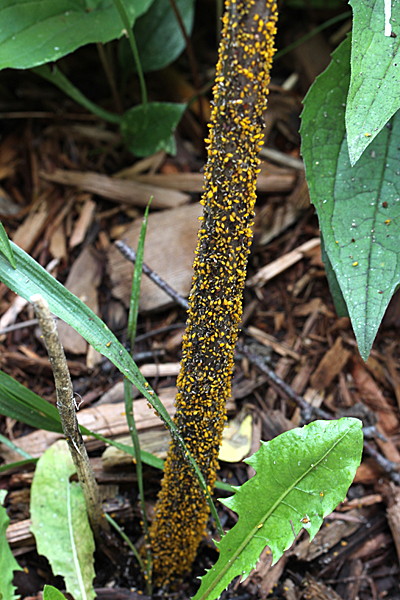One of the swamp milkweed clusters in the backyard is infested with aphids, in particular the milkweed aphid, Aphis nerii. The population density is so high that you can hardly see the stem or the pod for all of the aphids covering it.

They have clustered on the tips of almost every pod and new stem. What you see in the photo are their balloon shaped abdomens sticking up, while their heads are down with mouthparts probing into the plant sap for the sugars being transported to the developing seeds. Those two black projections are not their legs, but cornicles that secrete a defensive, waxy fluid (see large aphid on top left center below).

Large population densities like this attract a variety of control agents. Two of the major predators on the aphids are ladybird beetle larvae and syrphid fly larvae.

I found several of these ladybird beetle larvae near the clusters of aphids. This one (above) was happily munching away on one of them.

This is the larva of a syrphid fly about ready to pupate. It’s about one-half inch long and has become rather immobile at this point. But they are quite active when hunting aphids and readily just mow them down.
A third potential predator may make an appearance soon. These are lacewing eggs, and the larvae that will eventually hatch are aphid specialists. These are the bugs you really want in your garden.

The larvae of the Green Lacewing look like this.

Green Lacewing larva attacking an aphid from Wikipedia
By far the greatest damage to the aphid population probably comes from the parasitic wasps that patrol the colonies. These tiny (one-eighth inch long) wasps crawl over, under, and around all of the aphids, probing them with their antennae and then sticking them with their ovipositor at the tip of their abdomen.

The wasp injects a single egg, which hatches inside the aphid body, and the wasp larva then consumes the aphid’s organs turning the aphid into a brown to black ovoid husk (center of photo below).

Aphis nerii are parthenogenetic, which means that they are all female, and produce clones of themselves by self fertilization. There are no males of this species in the U.S., and thus no sexual reproduction. They are also viviparous, giving birth frequently and to many offspring at one time. If you watch these aphids long enough, you can see the tiny yellow blobs emerge from one of these very swollen yellow bellies.
When populations densities get this high, or when the food supply becomes exhausted, many of the aphids will develop wings to disperse to new feeding areas, where they once again undergo a rapid population explosion.













